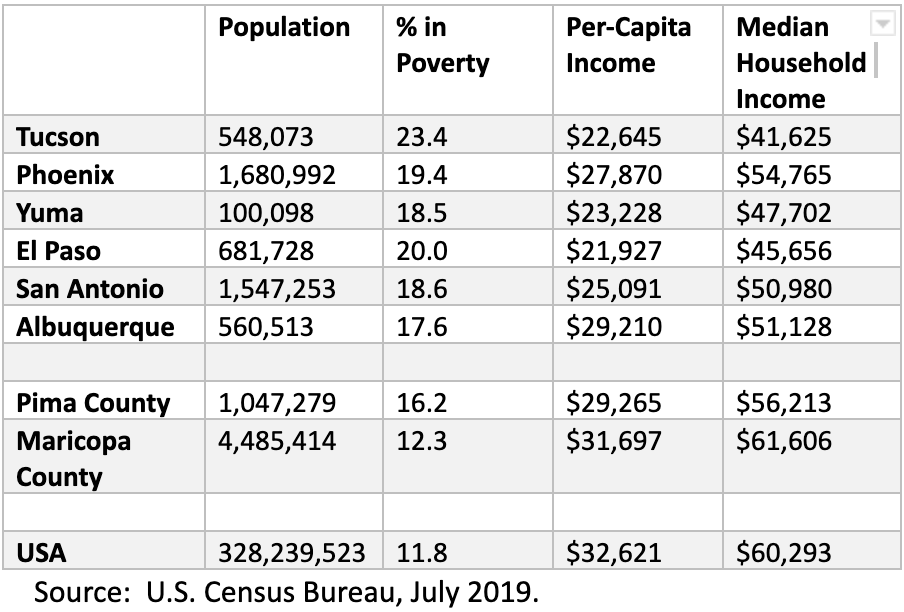The Tragedy of Tucson: First in a two-part series on why the Old Pueblo isn’t prosperous
With 1.05 million people, metro Tucson is Arizona’s second-largest metropolis. About 56% of that population is in the City of Tucson, about 36% is in unincorporated Pima County, and the remaining 8% is in the relatively nice suburbs of Oro Valley and Marana.
Once the territorial capital of Arizona, Tucson has a milder climate than Phoenix and is located in a prettier natural setting. But Tucson has fallen far short of its potential and lags behind Phoenix in key measures. It also lags behind other cities that, like Tucson, were once part of Mexico and, before that, part of the Spanish Empire. To wit:
Tucson Vs. Other Locales Poverty and Income

If the above were not bad enough, the City of Tucson has one of the highest rates of property crime in the nation. Moreover, its largest school district, the Tucson Unified School District, has some of the lowest test scores and graduation rates in Arizona. On the plus side, its University High School is one of the best in Arizona and it has some good private schools and charter schools, including the world-renown Basis schools. Generally, schools are better in the northern suburbs and in the southeastern suburb of Vail.
In a case of too little too late, residents of the city have voted for increased spending on city roads and parks, which are in terrible shape due to decades of deferred maintenance. Roads in the surrounding county are so bad that 90% of them are rated as substandard or failed. Even in wealthy neighborhoods in the Foothills to the north of the city, pavement is badly crumbled, alligatored and potholed. There are even some dirt streets just a couple of miles north of the city limit, smack in the middle of suburbia.
Blight of course goes hand in hand with poverty, but the rundown and seedy condition of much of the metropolis has nothing to do with poverty. It has to do with bad zoning, bad code enforcement, bad government, and bad maintenance of both public and private properties. Arterial and collector streets are littered, illegal signs and banners proliferate, landscaping is sparse, and tacky strip malls dominate the scenery.
In 1970, Life Magazine designated the major east-west thoroughfare of Speedway Blvd. as the ugliest street in America. Unfortunately, it is not the only ugly street in the metropolis.
Rivaling it for the top honor is Oracle Rd. (State Route 77), a major north-south artery that runs from center city, through a few miles of unincorporated county, and then through the town of Oro Valley. The ugliness of the stretch in the City of Tucson makes one weep in despair, but the stretch north of the city makes one consider suicide. The latter is devoid of landscaping and sidewalks but is full of weeds, litter and breathtakingly ugly commercial development. Judging by the condition of this state route, the state must hate Tucson, or maybe the state knows that Tucsonans will tolerate being treated as second-class citizens.
Downtown Tucson has been somewhat revitalized, but it came at the expense of a redevelopment boondoggle known as Rio Nuevo, which wasted $200 million, according to some estimates. If governmental incompetence were a salable export, Tucson would be richer than Silicon Valley.
Tucson is off the radar as a headquarters location by large corporations. This results in a brain-drain, as talented young professionals, including graduates of the University of Arizona, tend to move elsewhere for opportunities. Hard data on how many leave and where they go cannot be found, but anecdotes suggest that popular destinations are Phoenix, Denver and Dallas.
How did metro Tucson get this way? The second part of this series will answer the question in detail, but here is a preview: Tucson’s troubles were purposely inflicted decades ago on the metropolis by a cruel establishment that benefited personally from the status quo and had one overriding goal: not to become another Phoenix.
This is the real tragedy of Tucson.

